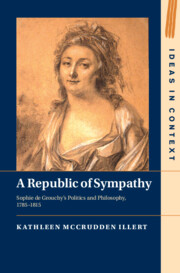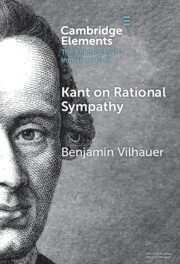Refine search
Actions for selected content:
97 results
Chapter 9 - Compassion-Based Therapies
- from Part I - Compassion in Healthcare
-
- Book:
- Handbook of Compassion in Healthcare
- Published online:
- 27 June 2025
- Print publication:
- 17 July 2025, pp 75-82
-
- Chapter
-
- You have access
- Open access
- HTML
- Export citation
Chapter 3 - What Compassion Is Not
- from Part I - Compassion in Healthcare
-
- Book:
- Handbook of Compassion in Healthcare
- Published online:
- 27 June 2025
- Print publication:
- 17 July 2025, pp 27-34
-
- Chapter
-
- You have access
- Open access
- HTML
- Export citation
7 - How Do Children Learn Right from Wrong?
- from Section II - Middle Childhood
-
- Book:
- Child Development
- Published online:
- 19 June 2025
- Print publication:
- 12 June 2025, pp 105-121
-
- Chapter
- Export citation
Chapter 32 - Shelley’s Laughter
- from Part III - Writings
-
-
- Book:
- Percy Shelley in Context
- Published online:
- 17 April 2025
- Print publication:
- 24 April 2025, pp 243-250
-
- Chapter
- Export citation
Chapter 16 - Byron and Shelley
- from Part II - Intellectual, Cultural, and Political Contexts
-
-
- Book:
- Percy Shelley in Context
- Published online:
- 17 April 2025
- Print publication:
- 24 April 2025, pp 121-127
-
- Chapter
- Export citation
Chapter 2 - Women and Children
- from Part I - Life and Death
-
-
- Book:
- Percy Shelley in Context
- Published online:
- 17 April 2025
- Print publication:
- 24 April 2025, pp 11-17
-
- Chapter
- Export citation
Chapter 5 - Literary Plants
- from Part I - Historical Periods
-
-
- Book:
- The Cambridge Handbook of Literature and Plants
- Published online:
- 06 February 2025
- Print publication:
- 13 February 2025, pp 90-108
-
- Chapter
- Export citation
Chapter 2 - Reading, Feeling, Acting
- from Part I - Protest
-
- Book:
- Vivisection and Late-Victorian Literary Culture
- Published online:
- 30 January 2025
- Print publication:
- 06 February 2025, pp 49-70
-
- Chapter
- Export citation
Chapter 20 - “Unfeeling Stone”
-
-
- Book:
- The New Nineteenth-Century American Literary Studies
- Published online:
- 02 January 2025
- Print publication:
- 23 January 2025, pp 297-308
-
- Chapter
- Export citation
Chapter 2 - The Local Environments and More-Than-Human Music of the Eclogues
-
- Book:
- The Environmental Poetry of Augustan Rome
- Published online:
- 12 December 2024
- Print publication:
- 19 December 2024, pp 60-97
-
- Chapter
- Export citation

A Republic of Sympathy
- Sophie de Grouchy's Politics and Philosophy, 1785–1815
-
- Published online:
- 18 December 2024
- Print publication:
- 05 December 2024
Introduction
-
- Book:
- A Republic of Sympathy
- Published online:
- 18 December 2024
- Print publication:
- 05 December 2024, pp 1-15
-
- Chapter
- Export citation
Chapter 1 - The Letters, 1786
-
- Book:
- A Republic of Sympathy
- Published online:
- 18 December 2024
- Print publication:
- 05 December 2024, pp 16-39
-
- Chapter
- Export citation

Kant on Rational Sympathy
-
- Published online:
- 02 December 2024
- Print publication:
- 02 January 2025
-
- Element
- Export citation
1 - Staging Sentimentality
-
- Book:
- Romantic Music Aesthetics
- Published online:
- 22 November 2024
- Print publication:
- 21 November 2024, pp 26-49
-
- Chapter
- Export citation
Rousseau and Kant on the Moral Value of Compassion
-
- Journal:
- Kantian Review / Volume 29 / Issue 4 / December 2024
- Published online by Cambridge University Press:
- 22 October 2024, pp. 551-568
- Print publication:
- December 2024
-
- Article
-
- You have access
- Open access
- HTML
- Export citation
New guidance for self-harm: an opportunity not to be missed: commentary, House
-
- Journal:
- The British Journal of Psychiatry / Volume 225 / Issue 2 / August 2024
- Published online by Cambridge University Press:
- 14 October 2024, p. 339
- Print publication:
- August 2024
-
- Article
-
- You have access
- HTML
- Export citation
5 - Romanticism, Sensibility, and Settler Women Poets
- from Part II - Networks
-
-
- Book:
- The Cambridge Companion to Australian Poetry
- Published online:
- 06 June 2024
- Print publication:
- 13 June 2024, pp 89-100
-
- Chapter
- Export citation
Joanna Baillie on Sympathetic Curiosity and Elizabeth Hamilton's Critique
- Part of
-
- Journal:
- Journal of the American Philosophical Association / Volume 11 / Issue 1 / March 2025
- Published online by Cambridge University Press:
- 18 March 2024, pp. 20-41
-
- Article
-
- You have access
- Open access
- HTML
- Export citation
6 - Loathsome Sympathy
-
-
- Book:
- Percy Shelley for Our Times
- Published online:
- 07 March 2024
- Print publication:
- 14 March 2024, pp 133-155
-
- Chapter
-
- You have access
- Open access
- HTML
- Export citation
